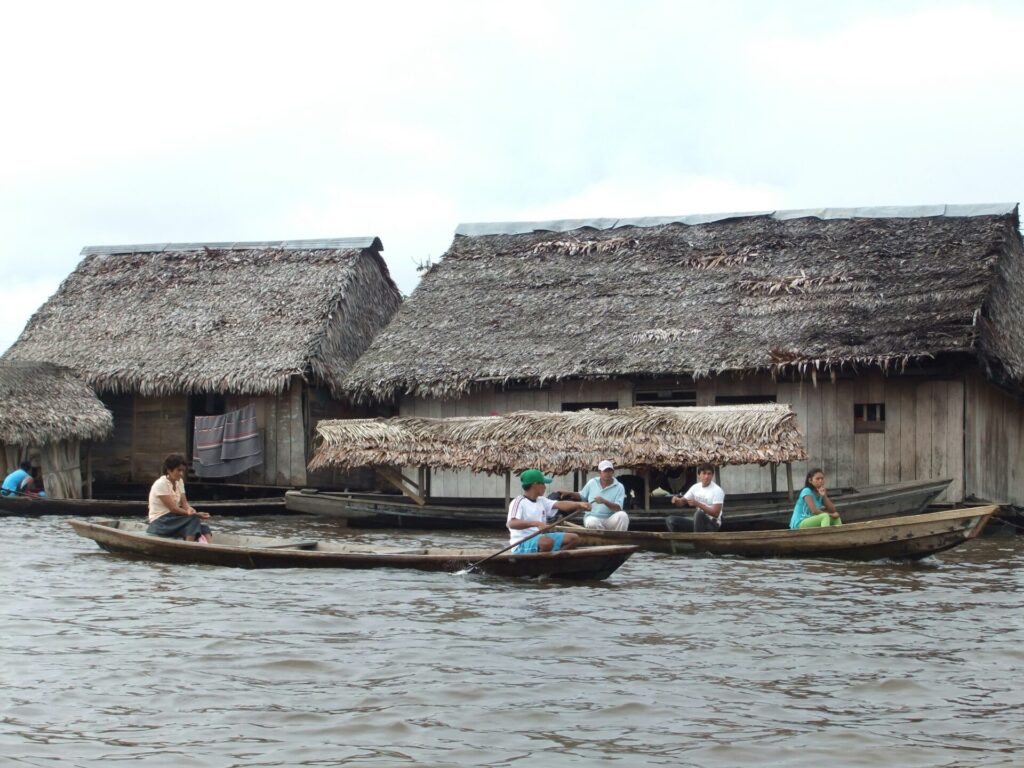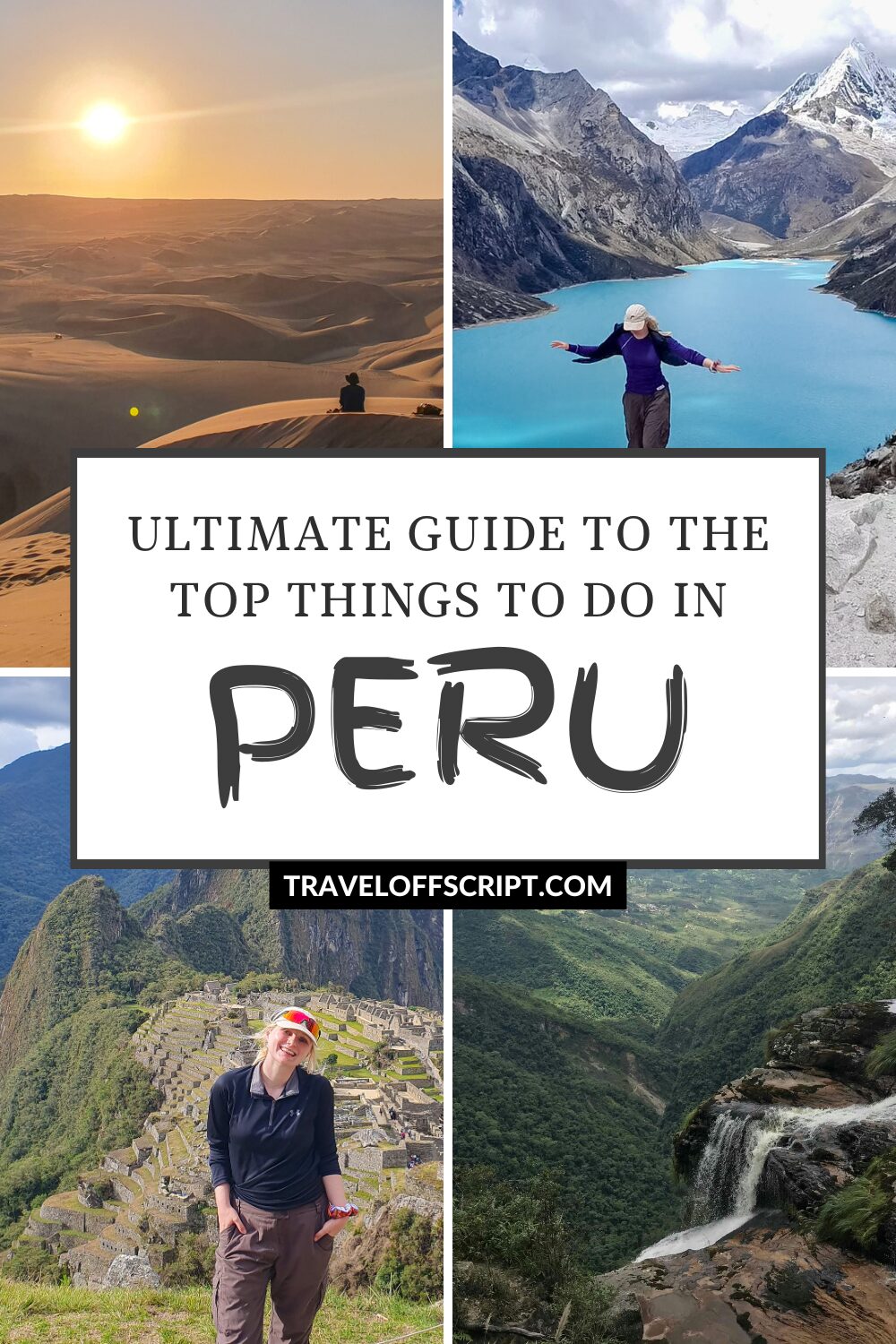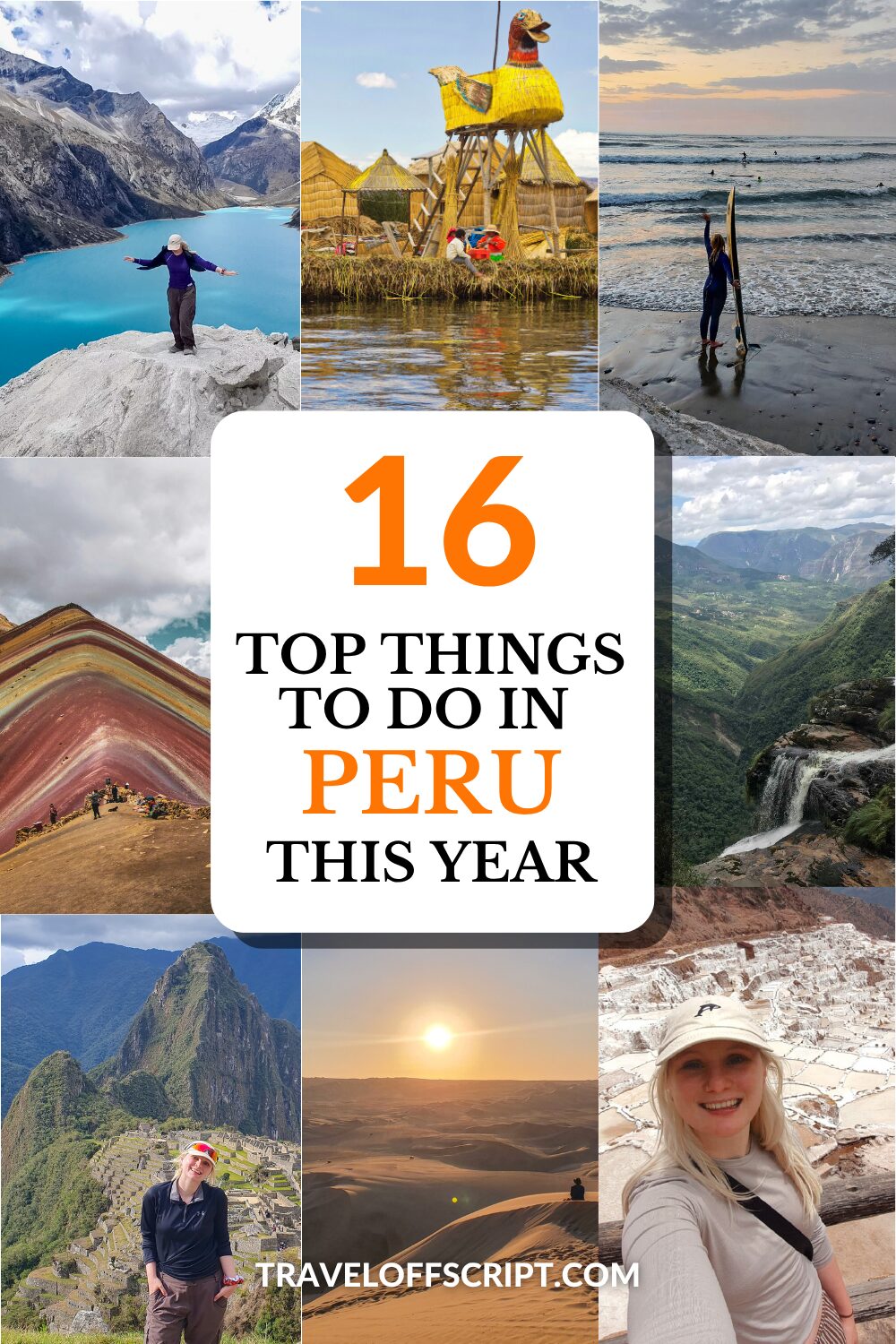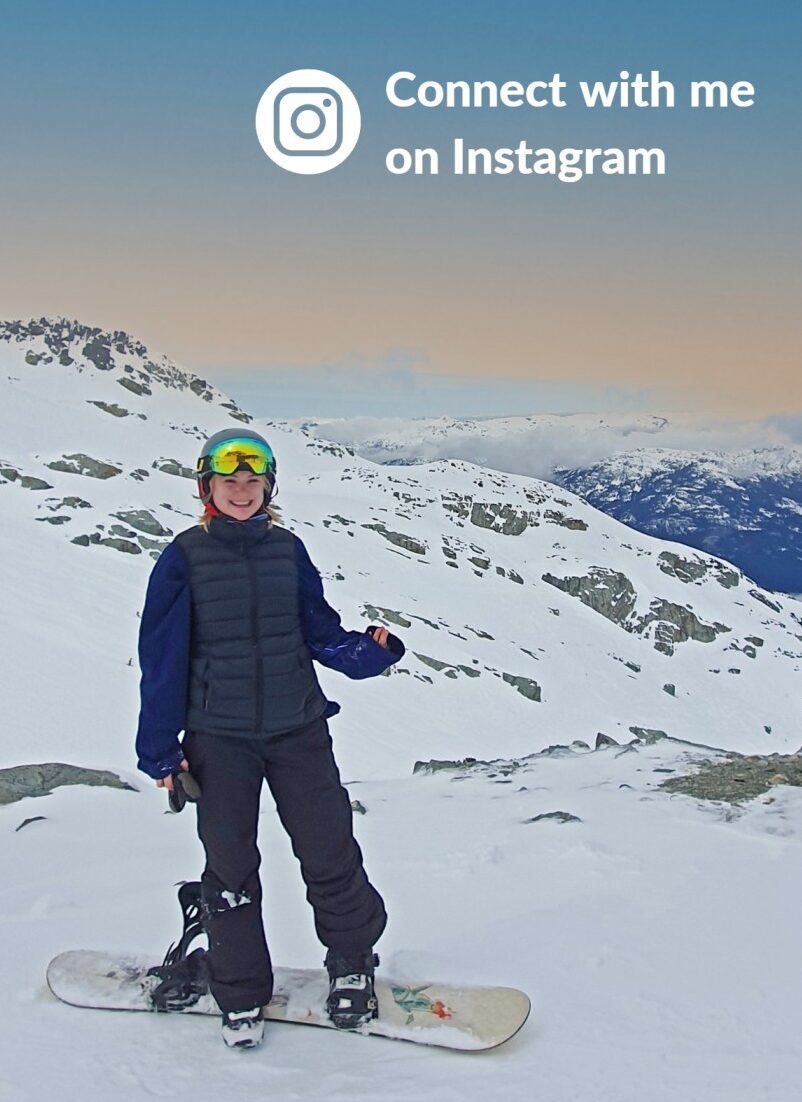16 Must Do Things in Peru
(Ultimate Travel Guide)
Peru is an incredibly diverse country, with experiences ranging from breath-taking multi-day hikes to ancient Inca ruins to surfing and beaches. Here are my must-visit places in Peru to add to your travel itinerary or bucket list!
Before heading to Peru, I honestly didn’t know much about the country except that it had Machu Picchu. Which (embarassingly) is also the only reason I went there from Chile, as it had been on my bucket list for years.
You can imagine my surprise when I ended up spending 5 weeks in Peru and loving every second. While Machu Picchu was a certain highligth and deserves to be on everyone’s bucket list, you should spend AT LEAST 2 weeks exploring more of what Peru has to offer.
I have summarised all of my favourite Peru travel stops below, together with accommodation and activity tips as well as any travel hacks from my time there!
This blog may contain affiliate links to support the running of the blog. If you make a purchase through these links, I will earn a commission at no extra cost to you. Thank you.
Table of Contents
ToggleHow to get to Peru?
Peru has only one international airport and that is Lima. You will either be arriving there or via the land border from Bolivia or Chile (in some cases also Ecuador or Colombia). You usually have to get out of the bus for border crossings and get stamped out of one country and another stamp to enter the new country.
Check out my full Lima Airport Guide here.
Once you have arrived, you will either fly to your next destination or get a bus. I did a combination of both and it will depend on your budget and timeline which makes more sense to you. Make sure to check out my full Peru bus guide here.
Important cities with domestic airports in Peru are Cusco, Arequipa, Puerto Maldonado, Trujillo, Cajamarca and Iquitos.
Information about Peru
Top things to do in Peru
1. Visit the stunning Machu Picchu
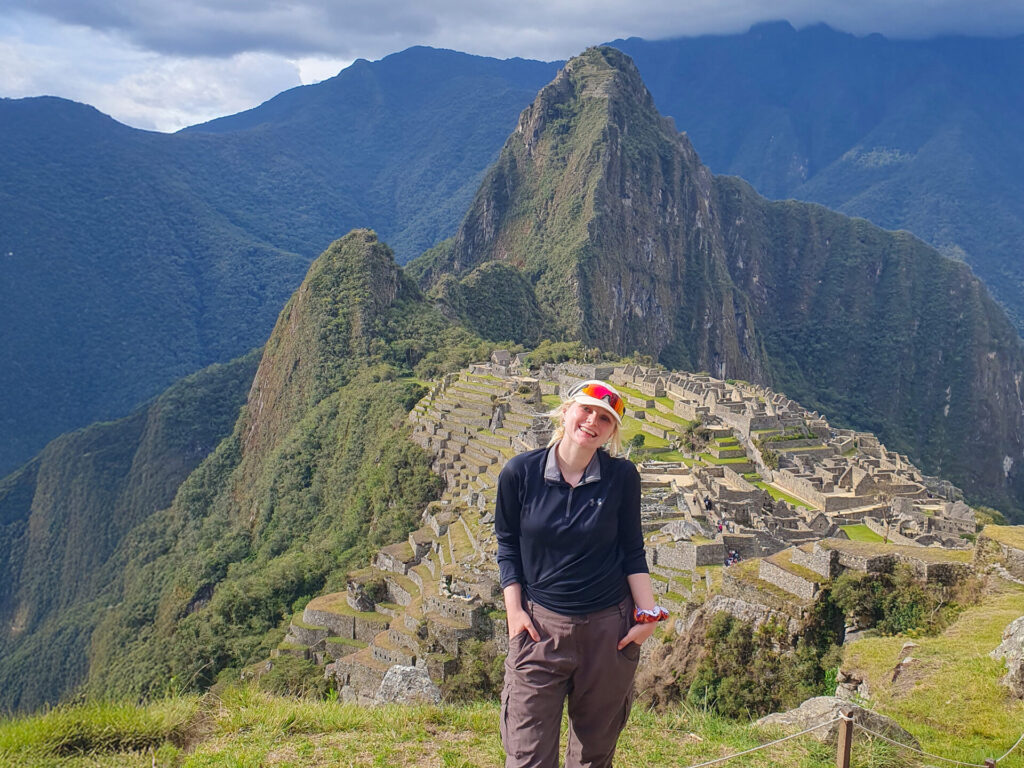
I have to start with Machu Picchu, because as famous and well-known as it is, it’s 1000% worth being on everyone’s bucket list. If you’ve never been before, it needs to be on your Peru itinerary.
I would highly recommend combining the visit with either the Inka Trail or the Salkantay Trek. They are both full of breath-taking vistas and you will learn so much more about the history of the entire area.
The Inka Trail:
I personally did the short 2-Day Inka Trail with Machu Picchu Reservations, who were the cheapest operator with good reviews. It included entry to Machu Picchu, transfer to and from Cusco, food and accommodation. It is worth checking out more expensive operators too, if within your budget, as I noticed that tours by e.g. Alpaca Expeditions got more historical and cultural information on each site than us. Their tour is about $100 more, so that is just something to keep in mind when deciding what to book.
The famous 4-day Inka Trail will set you back starting at around $700. It is a once-in-a-lifetime experience so if you have the savings and are early enough to book it (I wasn’t hence the short one), I would highly recommend doing so.
The Salkantay Trek:
The Trek is easier to book than the Inka Trail as there is no regulation on how many people can go, so it does not sell out. Some tours include Machu Picchu tickets, some expect you to organise these yourself (especially if booking late). You can do the famous 5-day trek with the Machu Picchu ticket included starting at $300, which includes meals and accommodation. This trek is more physically demanding and more about nature, but a traveller favourite.
Machu Picchu Only:
If you are just wanting to do Machu Picchu, you can either buy a day tour or organise it yourself. If you do it yourself, BOOK TICKETS EARLY!!!! I cannot stress this enough. You do not want to queue in Aguas Calientes the night before (check out my guide on how to do it though, if you end up in that situation).
From Cusco, make your way to Aguas Calientes by taking a bus to Ollantaytambo and then the train from there to your final destination. From Aguas Calientes, buses go up to Machu Picchu in regular intervals. You don’t need to prebook but just queue in the morning – return tickets are $24. Head up with plenty of time to spare to make your time slot. Circuit 2 is the best to have both the famous view and see the actual city, Circuit 1 has the postcard view of Machu Picchu but no city.
2. Step back in time in the Sacred Valley
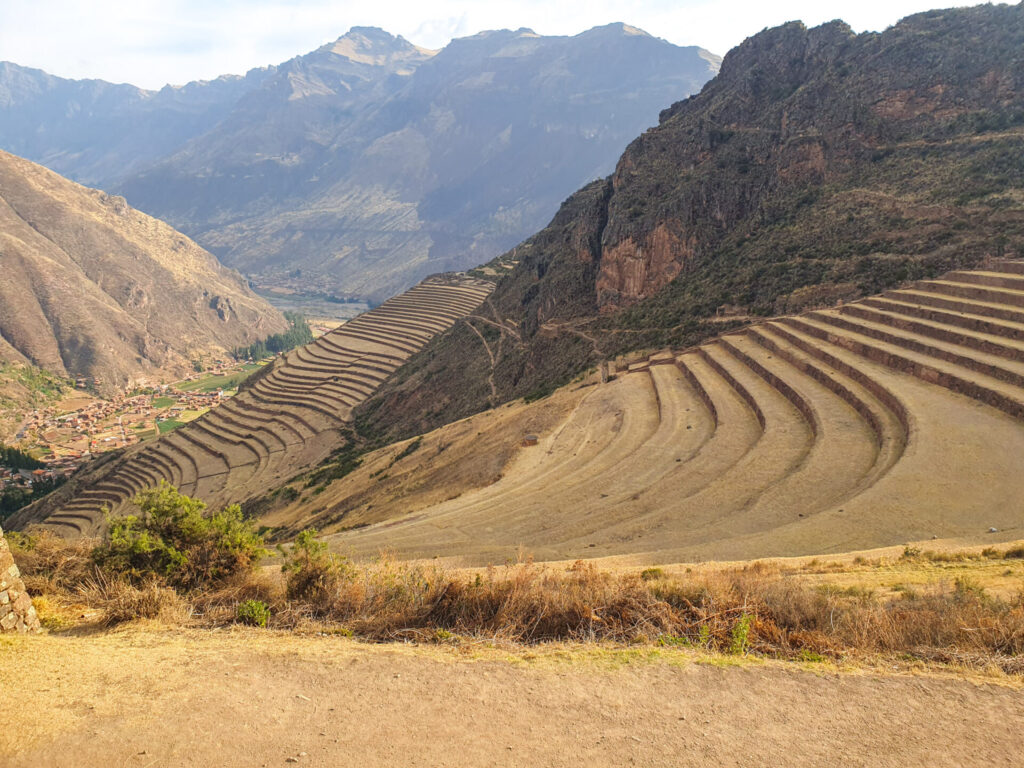
If I could change one thing about my time in Peru, it would be to spend a few days in the actual Sacred Valley. I did a one-day tour from Cusco and it just felt a little rushed (though still a good option for those on a strict itinerary).
Sacred Valley is so full of history and culture, from the hilltop Inca citadel of Pisac to the fascinating Maras Salt Mines to the impressive Ollantaytambo Inca ruins.
Accommodation:
There are many great options, including the Skylodge Adventure Suites where you sleep in a glass dome hanging off the side of a mountain. Pisac has an incredible market full of hand-crafted items that makes it worth staying at least a night, check out the Hotel Pisac Inca. Urubamba is full of luxury resorts for those needing a rest day before or after the Inka Trail, Miski Samay Domo Boutique is a great one.
How to get around:
A great budget-friendly way is by shared vans and minibuses, you will find them in the city centres (though double-check departure points with your accommodation) and they will usually have signs in the window of where they’re headed. Otherwise you can always ask your accommodation to call a taxi and even make special deals with the drivers if you want to see several things in one day.
3. Explore the historic Cusco
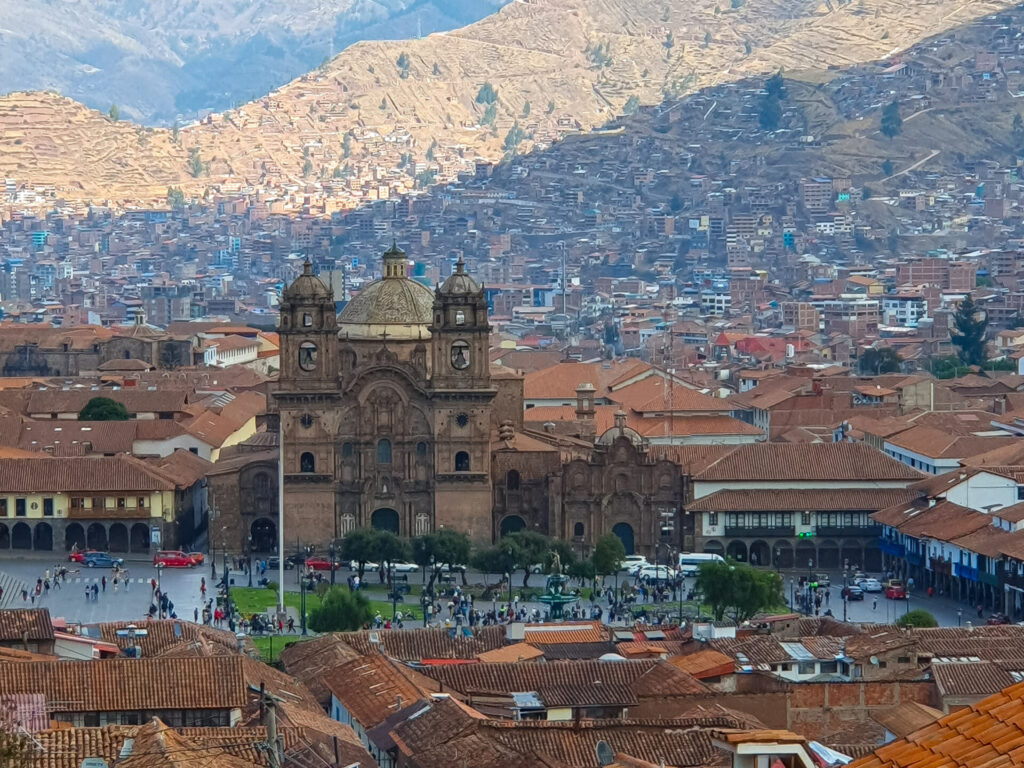
Cusco is the gateway to the Scared Valley and Machu Picchu, and you should spend at least 3 days here acclimatising to the altitude. That means plenty of time to explore this beautiful, historic city and go on a tour or two.
There are several free walking tours (where you tip at the end), which are a great way to get an initial feel for the city from a local’s perspective. Make sure to also check out San Pedro Market for affordable souvenirs and local food, as well as the incredible city views from the San Cristobal Church.
There are many incredible day trips too, such as Humantay Lake.
Accommodation:
Check out my full guide on Cusco Accommodation here. Some of my favourites:
$ – Viajero Hostel Cusco
$$ – Atoq San Blas Hotel
$$$ – Palacio del Inka, a Luxury Collection Hotel
4. Go off-grid in the Amazon
The Amazon River is the largest in the world, originating in Peru and flowing through Brazil, Colombia, Ecuador, Bolivia and Venezuela. Peru is one of the best places to see the rich wildlife of the Amazon and experience life off-grid in the rainforest.
The three main starting points in Peru for Amazon tours are Puerto Maldonado, Iquitos and Manu National Park. The easiest to reach from Cusco is Puerto Maldonado, a 9-hour bus ride or 1-hour flight.
The Amazon Rainforest is easily one of the most magical places on earth, just make sure you bring a good bug spray (minimum 20% DEET).
Accommodation (Puerto Maldonado):
$ – Don Jaime Hostel
$$ – Enai or Kapievi Ecovillage
$$$ – Hacienda Herrera
5. Eat your way through Lima
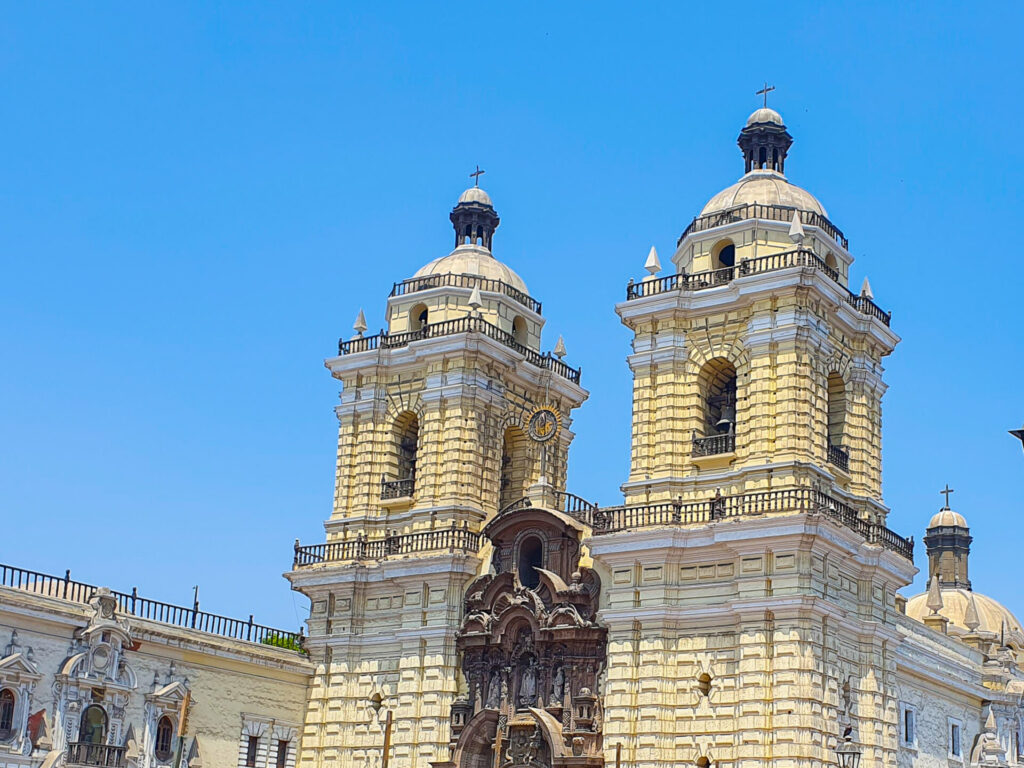
A lot of people have mixed feelings about Lima, I really enjoyed the city. First of all, the food options here are incredible. Second, the areas of Miraflores and Barranco are beautiful and there are so many things to do. Here is my full guide on what to do in Lima.
One thing you cannot miss is this food tour. The amount of different, local food we got to try was incredible. From street food to Ceviche to exotic fruit to snacks in Chinatown – you certainly won’t need breakfast before this tour. The perfect introduction to Peruvian cuisine.
If you prefer smaller groups (the free tour had up to 30 people), I can recommend this tour:
Accommodation:
Check out my full guide on accommodation in Lima here. Some of my favourites are:
$ – Viajero Kokopelli Hostel Barranco
$$ – Belma Boutique Bed and Breakfast
$$$ – Miraflores Park, A Belmond Hotel
6. Hike up to Rainbow Mountain

Rainbow Mountain is one of the most popular day trips from Cusco and for good reason. It is locally referred to as Vinicunca and made up of 14 different colourful minerals.
It is a pretty tough trek to get to the mountain, which is located at 5,100 meters above sea level. Oxygen at this altitude is very low, so remember to acclimatise beforehand and possibly take anti-altitude sickness medication.
There are a limited amount of horses available to take you up the mountain, though I would only encourage this if hiking isn’t an option for you. The weather here is pretty unpredictable, so pack in layers and keep an eye on the forecast to avoid sudden snow.
7. Sandboard the biggest sand dunes in South America in Huacachina

Huacachina is a small desert oasis, full of hotels, bars, restaurants and most importantly, lots of adventure sports. It was one of my favourite stops of my Peru trip. Huacachina is located 4 hours from Lima by bus (or overnight bus from Cusco). You get off at Ica and then get one of the small TukTuk taxis to Huacachina – this shouldn’t cost more than 10 soles.
Activities:
The most popular activity is sandboarding, either on a normal sandboard that you lie on or for skiers and snowboarders, with real equipment. Tours are every evening with sunset included and prices range from £15 to £45 for tours with the “real” ski/snowboard equipment. They also include sand buggies that race you up and down the dunes, which feels like a rollercoaster. If you are a few people you may be able to haggle down the price too. I went on this tour with Dito Sand Xsports and they were fantastic.
The dunes are the largest in South America and are truly impressive. I loved climbing them and watching the sun set, turning the sand into a sea of gold. Seeing the Oasis and hotels surrounding it light up was also beautiful. At night, Huacachina is super lively with karaoke, party games and so much more.
Accommodation:
Check out my full accommodation guide here. Some of my favourites:
🛏️ Viajero Huacachina Hostel – a great, budget-friendly option especially for solo-travellers and those looking to socialise
🏕️ Dunacamp Huacachina – sleep under the stars in a luxury tent in the middle of the desert in this all-inclusive, activity-filled stay
🏨 Senoma Hotel – an elevated hotel experience at a good price
8. Go on some of the most incredible hikes in Huaraz

Huaraz is in the north of Peru, about eight hours by bus from Lima (or a short flight). It is known for some of the most beautiful hikes in Peru, arguably even in the world (just Google the Huayhuash trek – 8 days of unrivalled views). Don’t worry though, you don’t have to hike 8 days to enjoy Huaraz’s beauty.
One thing to note about this town though is the altitude. It sits at a lofty 3,052 m with a lot of the popular hikes going up to over 4500m. I’d highly recommend planning in time to acclimatise and consider taking altitude sickness medication.
Best hikes:
- Laguna Paron – I did this hike as there are very easy tours with limited walking and I wasn’t doing too well with the altitude. The easy tour drops you very close to the lake, from which you can then hike up to the viewpoint which takes 30-45 minutes. The mountain in the back of the lake called Artesonraju is supposedly the inspiration for the logo of Paramount Pictures.
- Laguna/Glacier Rocutuyoc – The other hike I did, also a more simple one including 1-2 hours of moderate hiking. The water of the laguna was stunning and the glacier fascinating to see.
- Laguna 69 – One of the most popular hikes, but it is also a little challenging as it is about 3 hours up to an altitude of 4500m. 100% worth it if you feel you can do it physically (listen to your body!)
- Laguna Churup – similar to Laguna 69, this is a challenging hike at high altitude but offers some of the most stunning views
- Huayhuash Trek – known as one of the most beautiful hikes in the world, this 8-10 day hike heads through untouched nature like you’ve never seen before. Very physically challenging!
Accommodation:
There are many amazing hostels and hotels in Huaraz. I stayed at Artesonraju Hostel and while I really enjoyed it, it’s located on top of a steep hill which made it really tough to get there after the long tour days in the altitude. I’d recommend something closer to the main town area. Check out Hospedaje Turístico Everest or Hotel Tupac.
9. Enjoy the surf of Huanchaco
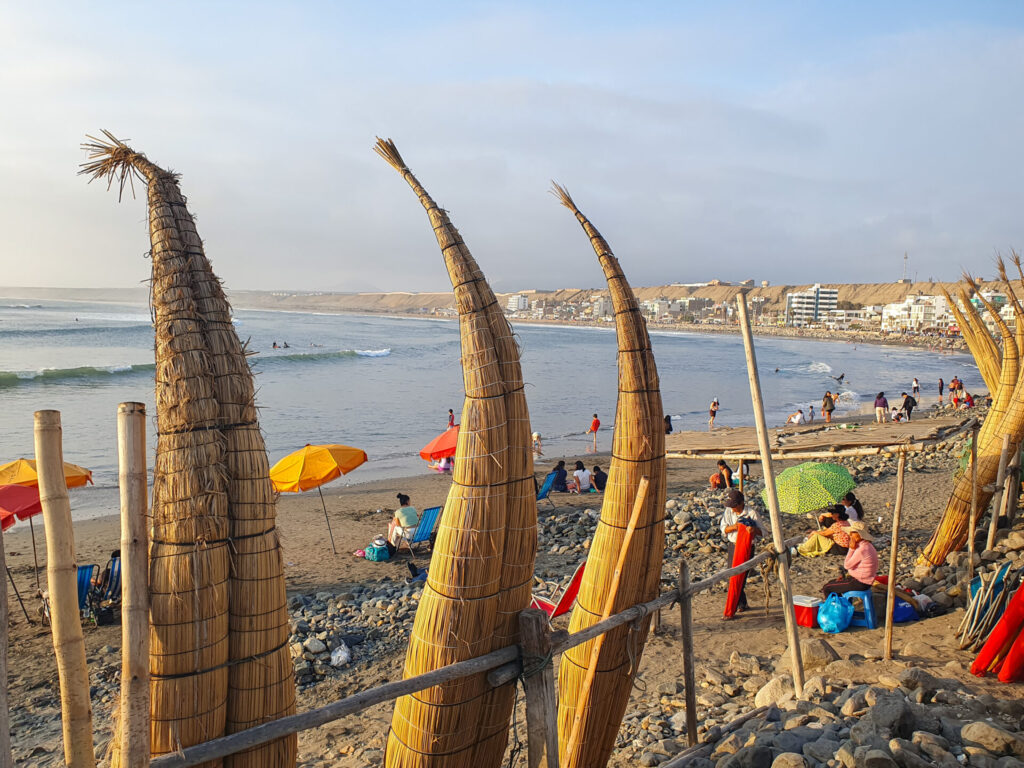
Also in the north but along the coast is Huanchaco, your typical surfer town. The vibes are relaxed and you can find some delicious food plus the nicest people.
On top of that, it is easily the cheapest place I have ever seen for surf lessons. Many 3-hour lessons start at around $20 (ask a few to get a feel for the best prices) – that is unheard of. Rentals are at most £5 per day, which makes Huanchaco the perfect place to learn or improve on surfing. Check out Koa Surf School for the best priced rentals.
About twenty minutes from Huanchaco is also Chan Chan, a pre-Columbian city that is now an archaeological site. The sheer size of Chan Chan is hard to comprehend and the history of it is fascinating. You can get there by public bus or taxi.
Accommodation:
Check out my full accommodation guide here. Some of my favourites are:
🛏️ Atma Hostel & Yoga – budget-friendly dorm and single/double rooms
🏨 Hotel Riviera Muchik– small but lovely, right by where most of the surf shops are
🏠 Spondylus – apartments, great for families or groups
10. Wander the “White City” Arequipa

Arequipa is known as the gateway to the Colca Cayon, but the so-called “White City” is well worth a visit itself. From beautiful architecture in the white volcanic stone to the history of Alpaca textiles, the city has a lot on offer.
Activities:
- Walking Tour – join one of the “free” walking tours to learn more about the city and its history, or try a smaller, private tour like this one
- Laguna de Salinas – beautiful white salt flats with flamingos and other water birds, a daytrip from Arequipa
- White Water Rafting – action-packed adventure on the Chili River near Arequipa
Accommodation:
Check out my full accommodation guide for Arequipa here.
🛏️ LOS ANDES BED & BREAKFAST– great hostel
💲Hotel Terrazas del Sol – central and affordable
🏨 Casa Andina Premium Cusco – A stunning hotel with beautiful rooms and great service
11. Marvel at the Andean Condor in the Colca Canyon
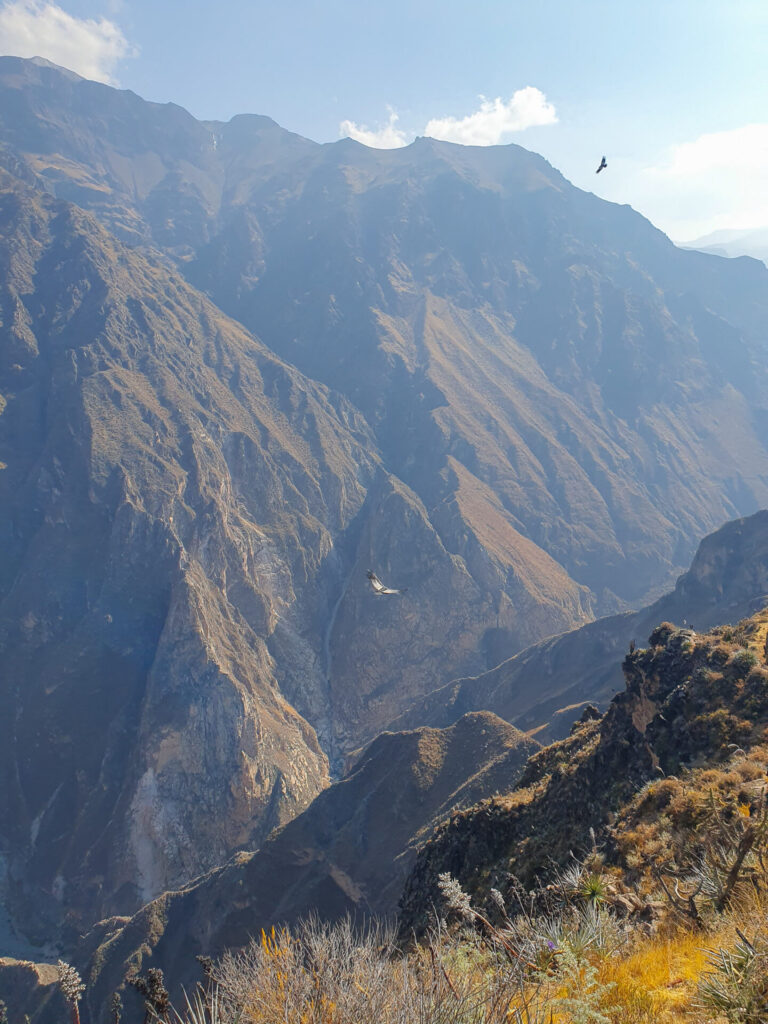
The Colca Canyon is why many people visit Arequipa and a must-do activity when in Peru. It’s a stunning nature reserve and actually the second deepest canyon in the world.
It’s about a four-hour drive from Arequipa, where you will pass 5000m at the highest point. I would highly recommend a 2 or even 3-day tour as one day is quite hectic. You can either choose to hike the canyon (do this if you can!) or do a car tour, depending on your fitness.
Colca Canyon is famous for the Andean Condor, one of the largest flying birds with a wingspan of over 3 meters. Seeing it glide through the canyon is a magical feeling.
Apart from the condors, Colca Canyon also offers beautiful views, traditional communities and incredible hot springs. I did a car tour with Tierra Milenaria as I wasn’t well enough to hike and our guide was incredible. He knew all the secret spots to see the condors. If you are able to hike, it is supposed to be even more incredible – I would recommend this tour.
12. Visit the largest lake in South America, Lake Titicaca

Lake Titicaca holds some impressive titles: highest of the world’s large lakes, around 3 million years old, covers 8 300 square km. It also spans two countries, Bolivia and Peru.
In Peru, one of the best access points is Puno, often called the folklore capital of Peru. From here, you can take tours to the islands of the lake where Andean people have lived isolated from the rest of the world for centuries. Check out the tour below.
Accommodation in Puno:
$ – Hostal Vista al Lago Titicaca Puno – super affordable and central hostel
$$ – Hotel Tierra Viva Puno Plaza – lovely rooms at fair prices
$$$ – Uros Waliski Lodge – a stunning stay right on one of the Uros Islands in the middle of lake Titicaca
13. See the mysterious Nazca Lines

I stopped in Nazca to break up the long bus ride between Cusco and Lima, and thought it was a super interesting spot. The famous Nazca lines, line drawings etched into the earth for mysterious reasons, are really a sight to behold.
To see them, you can either book a flight (expensive but very cool), or head to the observation deck.
To get to the observation deck, head to the local bus terminal (map location) and ask for a ticket to the observation tower (6 sol). The bus is the same that goes to Ica, so also mention that your destination is the observation deck when getting on the bus so that it definitely stops. Getting back can take a while as you need to wait for the bus on the opposite side of the road of the tower – look out for a Peru Bus as that is the one you want.
The tower itself also costs 6 sol and you get a great view of about 3-4 of the Nazca line drawings. This way of seeing the lines is super affordable.
Accommodation:
I stayed at Hospedaje el Telar and would really recommend it. Another great stay in Nazca is La Familia Nasca House.
14. Explore the desert landscape of Paracas National Reserve
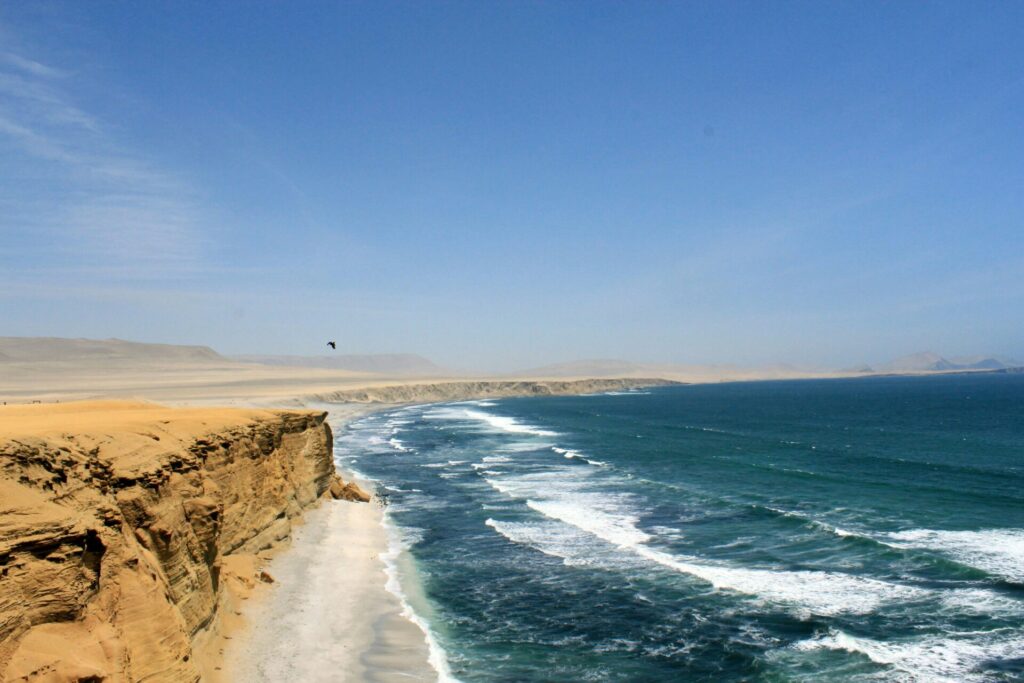
This national reserve, close to Peru’s capital Lima, is home to a coastal desert, several islands and surrounding marine habitats. One of the most popular daytrips from Lima is to the Ballestas Islands of Paracas, which are often called the Galapagos of Peru. On the trip, you will encounter a ton of marine wildlife, such as sea lions, Humboldt penguins and pelicans.
However, there is more to discover in the National Reserve and you could even stay a night in Paracas before heading on to e.g. Ica after. From the town you can take countless tours, including bike and quad tours into the desert and its unique landscapes.
15. Head to Peru’s tallest free-falling cascade, the Gocta Waterfalls
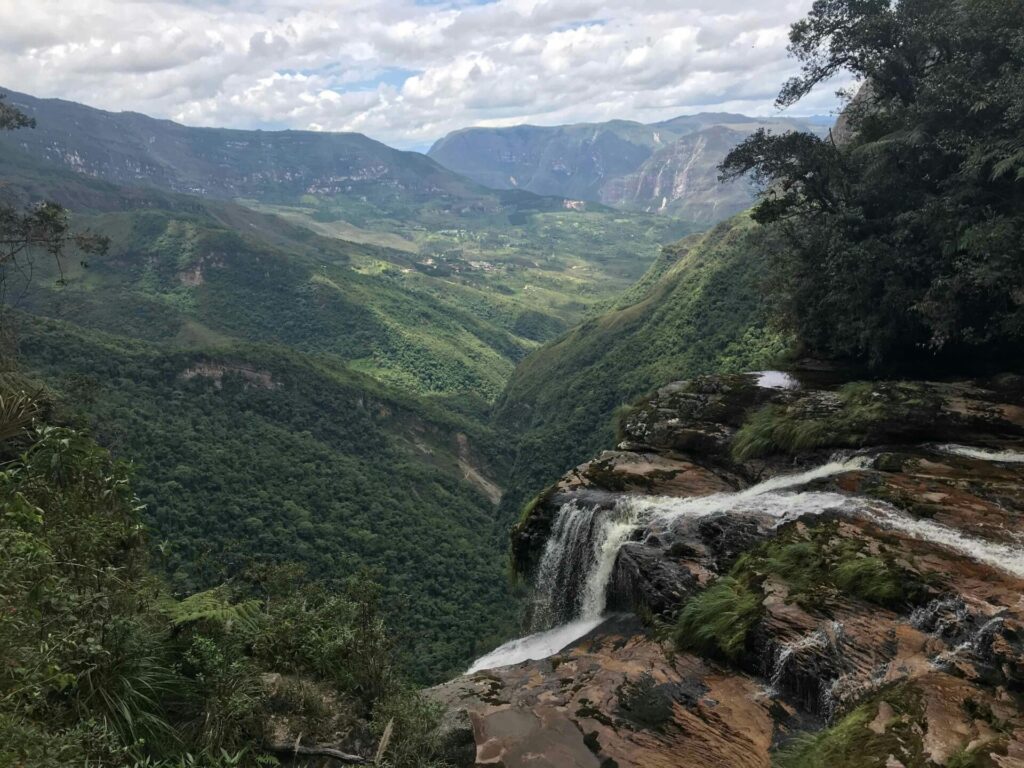
The Gocta waterfalls are located in some of Peru’s most beautiful landscapes, yet they rarely make people’s Peru travel list as they are quite far north. If you have the time, this area of Peru is well worth adding to the itinerary. Other notable sights in the area are the Kuelap fortress and the The Caverns of Quiocta.
These waterfalls are one of the tallest waterfalls in the world, reaching 771m along two drops with a powerful free-fall from the second drop. The hike to get there is challenging, but so worth it.
Some of the trekking options include:
- full circuit from San Pablo to Cocachimba, which allows you to see both the upper and lower part – 15 km
- the more accessible route from Cocachimba – around 10km total
How to get there:
You can either stay in the nearby bigger city Chachapoyas or choose one of the small hiking hotels right in Cocachima. Chachapoyas is a 13hour night bus away from Cajamarca (see point 16) and then a collectivo will take you to Cocachima.
Accommodation:
Chachapoyas:
Hotel Dordéan Casona Boutique
Chachapoyas Backpackers Hotel Boutique
Cocachimba:
Mamaq Tambo Lodge
La Casa de Mario
16. Enjoy the off-the-beaten path activities of Cajamarca
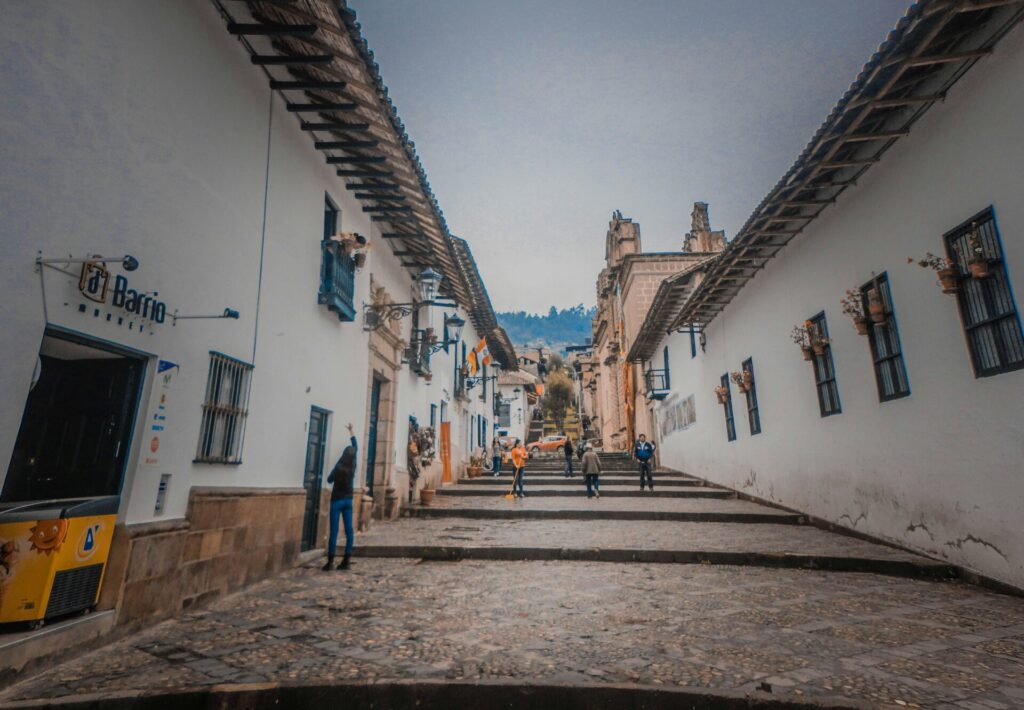
In the North of Peru, nestled in the Andes mountains, you will find the beautiful city of Cajamarca. The place is full of Inca history, amazing hot springs and lots of fun activities. For tours, check out local operators in town and ask your hotel for recommendations too.
Activities:
- Cumbemayo – a so-called stone forest about 40 minutes from Cajamarca, you will be able to explore the beginning of the pre-Inca aqueducts here in an amazing feat of man meets nature
- Ventanillas de Otuzco – a pre-Incan necropolis consisting of hundreds of windows carved into the stone wall. It is said to belong to the Cajamarca culture (200 AD -800 AD)
- Banos del Inca – the hot water baths of this area are well-known for their healing properties and this area is full of them. Choose from public to private baths starting from just S/6 to S/20 ($1.80-$6)
Accommodation:
$ – Casa Mirita
$$ – Casa de Pablo
$$$ – Wyndham Costa del Sol Cajamarca
You may also be interested in:
When is the best time to visit Peru?
The best time to travel to Peru depends a little on the region you are planning to explore. May to October is the dry season which makes it great for hiking and exploring. November to April is the rainy season, though I visited in late October – mid November and had little issues with rain and less crowds.
According to locals in the Amazon, the best time to visit is actually November – June as the transition period means the trees are blooming and wildlife is out and about.
How many days should I spend in Peru?
I would recommend an absolute minimum of 10 days, which would probably include Lima, Cusco, Machu Picchu and Sacred Valley. 14 days would allow you to add e.g. Arequipa and Puno, or Huacachina and Paracas.
In my opinion, the longer you have, the better. I stayed for 5 weeks and still didn’t make it all the way north, there is just so much to do and see.
3 weeks is a sweet spot as it allows you plenty of time for the main spots (including time for acclimatisation) and some time for places a little out the way such as the Amazon.
Is Peru safe for tourists?
I travelled Peru as a solo, female traveller and felt very safe in this country. Especially in the big tourist hub destinations, such as Cusco, I was able to walk around at night without any worries.
As with any country, it is crucial to do your research before the trip as well as follow some safety guidelines. I have summarised all the important ones for Peru in this blog post, I’d recommend saving it and checking it out before your trip. It is written specifically for solo, female travellers, but the tips and recommendations in it apply to everyone.
A few quick safety tips:
- knowing a little Spanish will really help you out in emergency situations (and make everyday life so much easier)
- Know which areas to avoid in cities, hostels/hotels will be able to help you with this
- Don’t flaunt your valuables and keep them close to your body
- Avoid empty alleyways at night
- NEVER put your valuable stuff in the overhead compartments on any bus, keep them on you (especially on sleeper buses). That is the only times I heard of anything happening to other people.
Hi, I'm Bell

I’m a solo traveller, writer and designer. I created my blog to share the many different ways to travel the world. Learn more about me here!
Latest from the blog:
Travel Off Script contains affiliate links to support the running of the blog. If you make a purchase through these links, I will earn a commission at no extra cost to you. Thank you.

